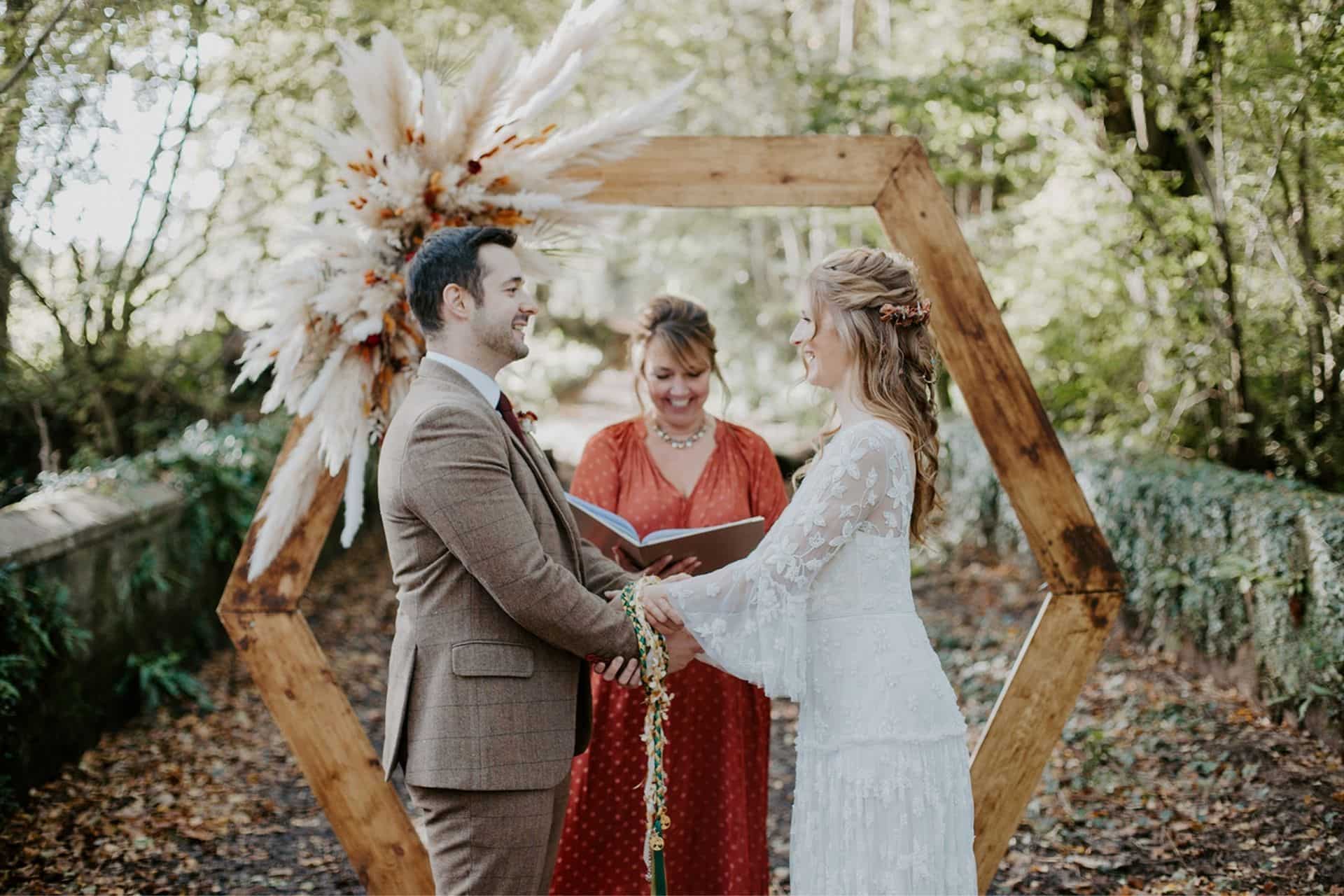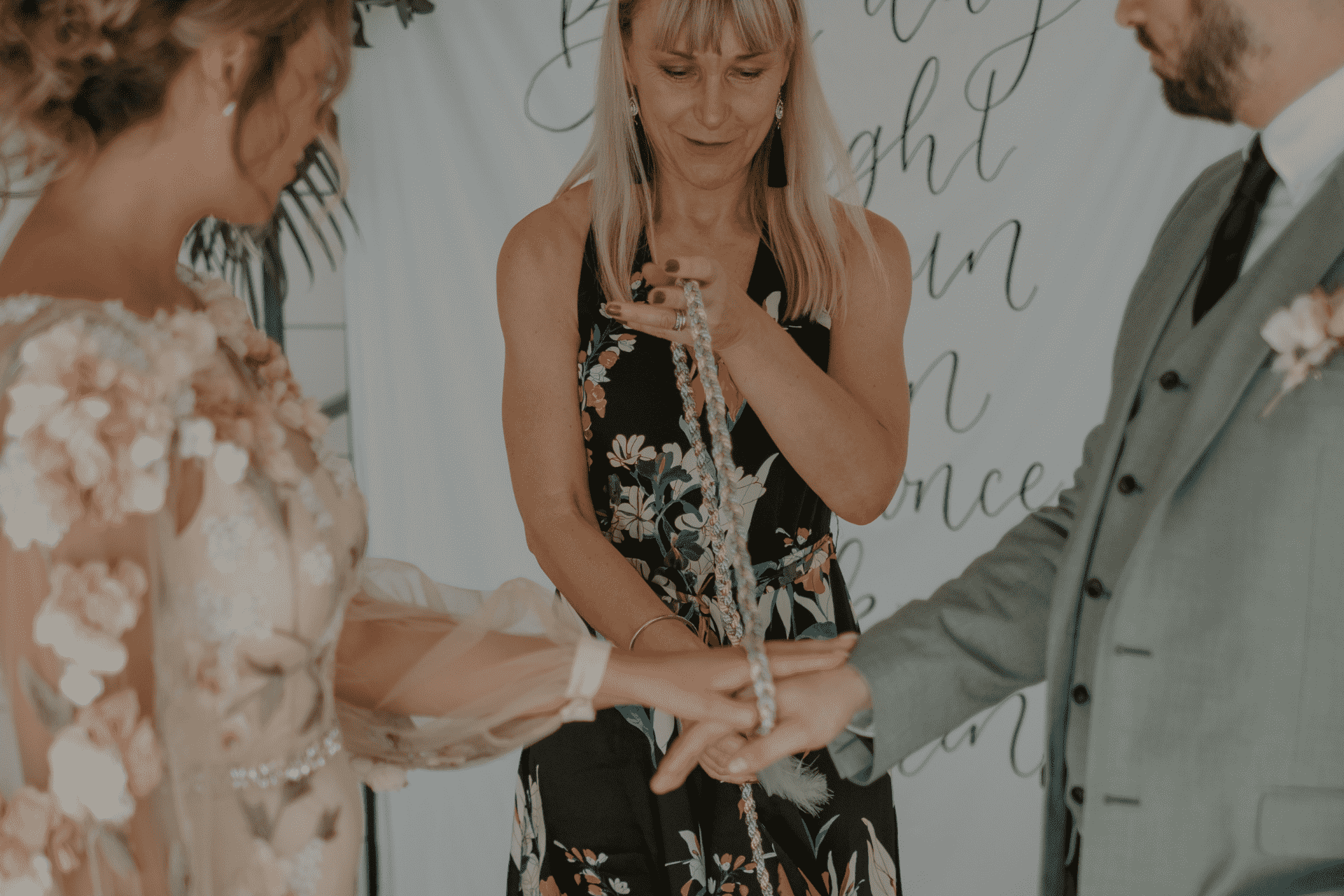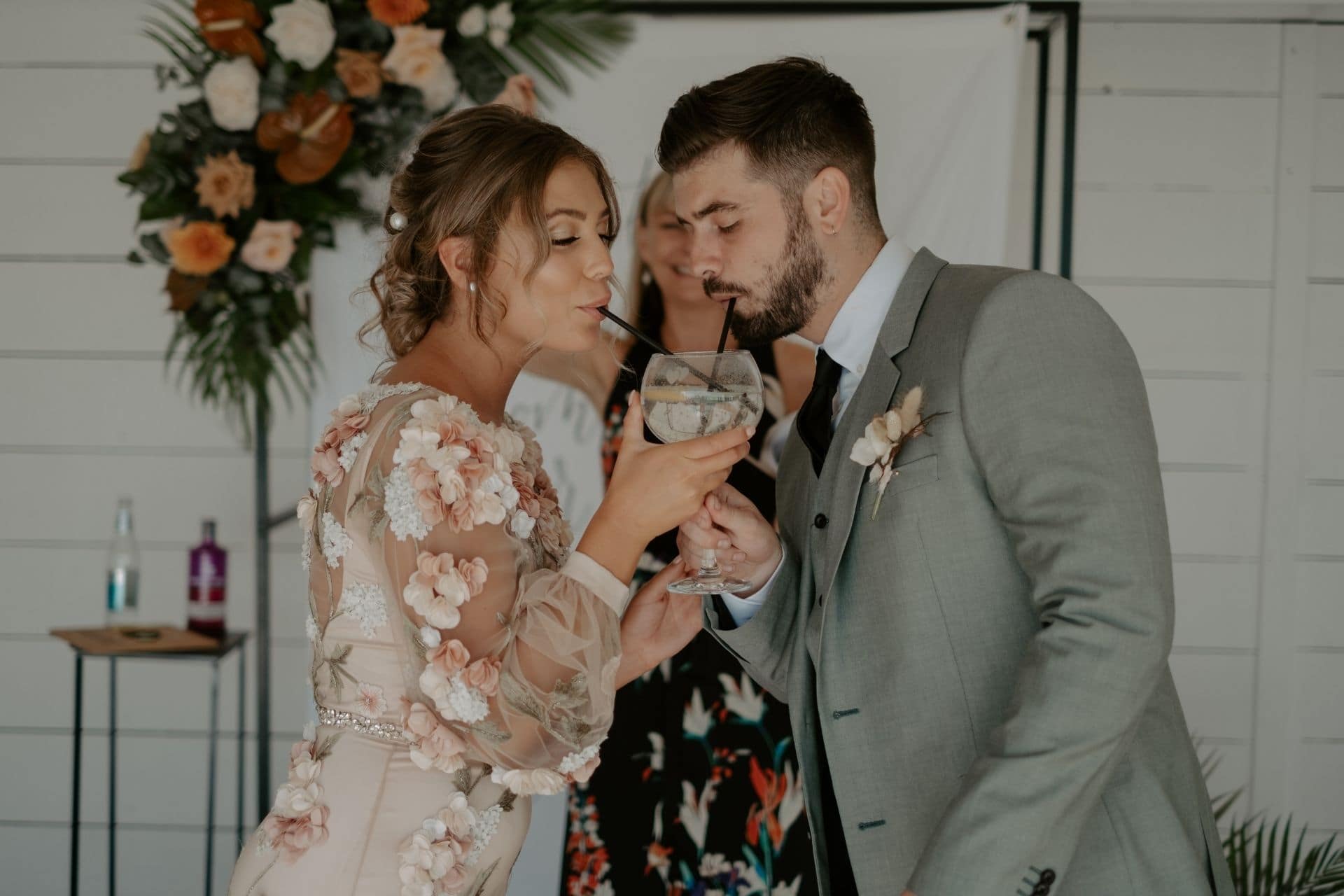In this section
What should I look for when choosing a wedding Celebrant?
What is the difference between a Humanist and a Celebrant?
Why would I choose a wedding Celebrant over a Registrar?
We married abroad but would like a ceremony in my home town, can this be done?
Getting Married in Spain: The ultimate guide to a Spanish destination wedding
Getting married in Scotland – The ultimate guide to a Scottish destination wedding
Getting married in Greece: The ultimate guide to a Greek destination wedding
Getting married in The Middle East: The ultimate guide to a UAE destination wedding
Getting Married in New Zealand – The ultimate guide to a Kiwi destination wedding
The Ultimate Guide to Handfasting
The joy of a celebrant-led wedding ceremony is that it gives a couple the freedom to create their own personalised, meaningful ‘big day’; a popular tradition many partake in is handfasting.
Handfasting dates back thousands of years and yet remains an incredibly popular way for people to show their eternal love in the presence of their nearest and dearest. It’s a ritual with a deep, spiritual origin as well as a strong connection to the natural world. It’s no surprise that it’s a tradition that countless couples (quite literally!) tie into their wedding day.
What is handfasting?
Handfasting is the practice of joining hands by crossing them side by side during a ceremony. This ritual binds a couples’ hands together – often with coloured ribbon or cord – to signify their neverending union of love.
Handfasting is a practice that can be enjoyed irrespective of your religious beliefs or any other cultural traditions. That means it is perfect for couples with a strong faith, interfaith or are non-religious entirely.
The benefits are huge, and the potential to personalise it further are abundant. That’s why we’re exploring this romantic tradition in our Ultimate Guide to Handfasting.
What is a handfasting celebration?
A handfasting celebration is a beautiful, ancient tradition that has found a new home in modern wedding ceremonies.
During the handfast, the couple will have their hands tied together, binding them into their new future as one. The phrase ‘tying the knot’ and shaking someone’s hand to agree something comes from this very act!
The celebration will be woven into the rest of the ceremony, accompanied by the beautiful, unique words of the wedding celebrant before, during and after the handfasting.
What is the history behind handfasting?
Handfasting dates back so far, it’s difficult to pinpoint its exact origin.
What we do know is that handfasting has been around for thousands of years and predates Christianity. It derives from a Celtric and Druid tradition; back then, couples could not just wander down the high street to buy a gold ring, and so handfasting became their marriage ceremony. It was a simpler, more accessible option; one that stuck… and we’re so glad it did!
Couples would pledge their commitment by binding their wrists with leftover strips of fabric (often torn from old garments) to symbolise their union, keeping the bind on until midnight. At this point, they would often be escorted to the bedchamber to consummate their relationship. Luckily, this is a part of the tradition that has moved on with the centuries and is thankfully not a part of the celebrant job description!
It was believed that if the couple could survive the physical obstacles of those hours then they would survive any obstacle that marriage threw at them. In the Scottish tradition, this was taken an (almighty!) step further by keeping their hands tied for a whopping 366 days. It wasn’t until the couple had managed this time tied together that they then had their second handfasting ritual; the actual marriage.

Is handfasting pagan?
While handfasting does have its pagan roots, there is no need to associate with the pagan religion in order to enjoy handfasting. It should be seen as a neutral option, with no focus on any single religion over another.
Unlike many traditions, it really is 100% secular. If you want to tie in god(s) and spiritual beliefs, you can… if not, that’s completely okay. The choice is ultimately yours.
Why do you perform a handfasting ceremony?
There are so many reasons to hold a handfasting ceremony!
Just a handful of the draws of adding a handfast ritual into your wedding day include:
- It’s undeniably romantic – it’s a beautiful gesture that can celebrate either a wedding or the amount of years you and your loved one have shared
- You can use the ritual to pay homage to other important people in your life; every ribbon or cord entwined could represent a different individual that has had an impact on your shared life
- You can go as big or as small a you like – your handfast could be as simple as the tying of hands, or you could enhance it by holding the service in a sacred site, such as Stonehenge or Avebury Circle
- They give you the opportunity to embrace all the festival vibes! Maybe you’ve seen handfasting at Glastonbury and want to recreate your own LOVEFEST or WEDFEST? Take the handfasting celebration out to the woodlands and you’ve got the perfect scenario.
- It’s famous! You’ve probably seen handfasting on Braveheart or Game of Thrones. If it’s good enough for the big screen…
- If you’re Celtic, this could be a wonderful way to really embrace your cultural tradition
- Handfasting offers the ultimate ‘mash’ of both traditional and ancient ceremonies and is a brilliant option for couples that are caught somewhere in the middle
- It gives you a lasting visual reminder of your union; many couples choose to turn their cord or ribbon into a gorgeous wall-hanging or frame it for display
But, for us, the biggest pull for handfasting is that it is for anyone and everyone. It doesn’t matter what your age is, what you believe in or what you want your ceremony to look like. It is an inclusive way to add something meaningful and memorable to your special day.
Who can perform a handfast?
This largely depends on the spiritual beliefs and cultural and social background of the couple.
It is important to remember that there are many different styles of a handfasting ceremony, and it will be up to you which style you most connect with. The next step will be to find an individual who can do that style justice.
As a ritual is not a legal ceremony, anyone can perform a handfast ceremony; however, most people will opt for a celebrant to lead the day. The benefit of choosing a celebrant is that they will have hosted this type of ceremony countless times before, and will bring with them rich experience and enthusiasm for the day. We would always recommend meeting or speaking with a selection of celebrants before you make your final decision; it’s important that you find one who can perform the celebration in the exact way you want.
Once you’ve made your choice, your celebrant will guide you through the different handfasting options so that you can craft the ritual in a way that fits in seamlessly with the rest of your ceremony.
You can browse our range of celebrants in The Celebrant Directory.
What do you say during handfasting?
Again, the beauty of a handfasting ceremony is that the couple can personalise it to encapsulate their unique relationship.
Typically, once the hands are bound the moment will be drawn out with the sharing of words. This could be vows – either personalised or a ‘repeat after me’ process with the celebrant, a blessing, a reading, a prayer, a brief admonishment about the partnership or something spoken aloud from all guests.

What do the different colours of handfasting mean?
The colours you choose for your handfasting ceremony can say SO much about you as a couple.
But fear not – you don’t need to be creative to perfect your handfasting ribbons. It simply comes down to choosing what you want to express through the ribbons and taking your inspiration from there.
- green symbolises growth, balance and harmony
- red is associated with passion,
- blue can mean trust and dependability
- yellow is linked to joy and optimism
- pink is associated with nurturing and romance
- and orange is linked to creativity
Some different ways you can use colour in the ribbons and cords of your handfasting include:
- Your past, present and future – every colour or fabric will represent a different period
- Your dreams, hopes and adventures as a couple
- Special people in your life – for example, if you have children they could be symbolised with one colour, your parents with another and so on
- Your personalities – you could have a yellow ribbon to express the joy in your partnership, a red for the passion, blue for the deep, thoughtful emotions
- Any promises that you are making for your marriage, such as gold for success or green for exploring the natural world as one
- Any faith communities that you hold dearly
- … or it could even just be in line with your wedding colour scheme!
The wonderful thing about tapping into the different colours and fabrics of your handfasting is that this can then be used as inspiration for your vows or promise to one another.
“I love it when the handfasting cords/ribbons are made from cuttings from bride’s mother wedding gown or groom’s late father’s shirt. Makes the meaning behind the cords so special!” Penny Boycott
How can you personalise the ceremony?
If you want to really embrace the Celtic tradition of handfasting, you could include beautiful traditional Celtic readings and have music played on lute, harp or drum. As with any type of ceremony, this is another opportunity to set the tone and mood of your overall ceremony.
The handfasting could be both sincere and reverent, nature-related and spiritual as well as fun and inclusive. You could also ask guests to end the ceremony by counting the couple down to jumping over the besom broom, culminating in the throwing of rose petals or breadcrumbs.
Handfasting has changed since its original inception, and today couples are being creative and imaginative in where and how they prepare and decorate the space for the ceremony. Much imagination can also be used in representing earth’s four elements. Some couples ‘go large’ and have a real fire pit and wind chime in the trees. Others rely on my elemental table where a candle burns and feathers or a bell represent air.
You can even get inventive down to the finer details such as the type of fabric you use for the binding; for example, couples who have enjoyed travels around the world may use fabric from a piece of clothing bought in one of their favourite spots. If the couple are keen climbers or horse riders they may use rope, or a bride may want to use a section of her mum’s wedding dress.
Your celebrant will help you with these MANY options; they will get involved as much or as little as you want. Some couples will know exactly what they want out of the ceremony, while others will crave more support. If needed, your celebrant will send you choices of suitable readings, vows, pledges and words of endearment to create the love, warmth and energy of their Handfasting.
Are there any other traditions that go alongside a handfasting?
Following the binding and tying of the hands, the couple may choose to partake in ‘Cake and Ale’ with a ceremony to toast their health and happiness and to symbolize the beginning of their life together.
Traditionally, ale was drunk but you can always choose your favourite drink instead. Some couples drink cider, beer, wine, mead, well water and even cold tea! A special two handled Scottish quaich or loving cup is traditionally used but many couples go even deeper on the tradition with goblets and animal horns.
A handfasting ceremony may also have a traditional ‘Jumping a besom broom’ ceremony to signify the creation of a hearth and home together. This tradition has long associations with marriage and cohabitation in not only Europe but Africa and America. Some couples may even choose to make their own besom broom!
Read more: 40 unity rituals from around the world

Is handfasting legal?
Handfasting is 100% legal to carry out. However, it is not a formal, legally binding declaration of marriage, but rather a historic and beautiful way to show your commitment and love for one another.
The easiest way to enjoy all the benefits of a handfasting ceremony – while having a legally recognised marriage – is to have a separate civil ceremony. This can be as simple as you and two witnesses at a registry office.
Saying that, there are certain countries (including Scotland, Ireland, Northern Ireland, Jersey, Norway, Iceland, Australia, New Zealand, South Africa, Canada and the United States) where you could have a Humanist ceremony, and it would be legally binding: you could therefore include the handfasting within that ceremony.
You can read more about how to legally marry with a celebrant here.
If you think that a handfasting ceremony could be the right celebration for you and your special day, then get planning! There are endless ways to be creative and truly capture the unique bond you and your partner share. So embrace it – show your individuality!
Photographer & Celebrant Credits: Debbie Skyrme, Nikki Wood, Deborah Page, Glenda Procter
Inspired by Glenda Procter’s original post on Handfasting